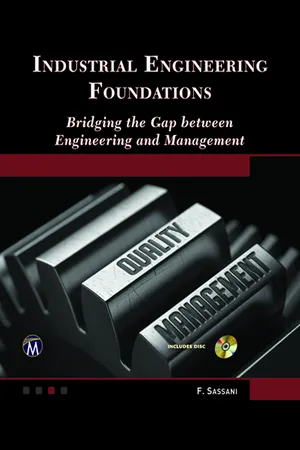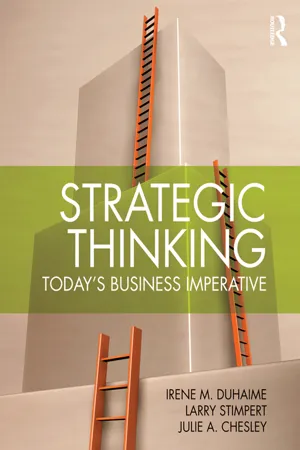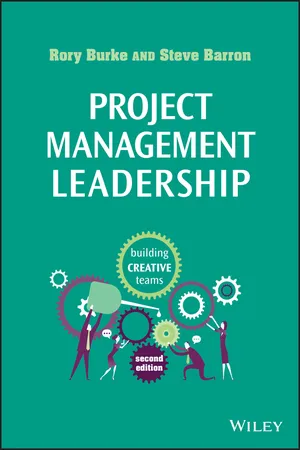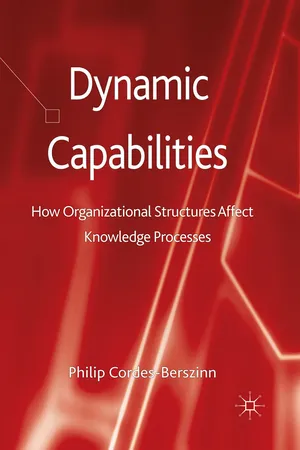Business
Organisation Structures
Organization structures refer to the way in which a company arranges its employees and activities to meet its objectives. Common structures include functional, divisional, matrix, and flat organizations. Each structure has its own advantages and disadvantages, impacting communication, decision-making, and overall efficiency within the business.
Written by Perlego with AI-assistance
Related key terms
Related key terms
1 of 4
Related key terms
1 of 3
12 Key excerpts on "Organisation Structures"
- Maureen Rhoden, Brian Cato(Authors)
- 2017(Publication Date)
- Wiley-Blackwell(Publisher)
12 Organisations and StructuresIntroduction
Organisational structures allow us to organise and deploy resources; define job activities, responsibilities and accountabilities. They help with decision making processes and communication flows in order to achieve the goals of the organisation. They help to create the power structure for the organisation and influence the identity and corporate image of the company. Organisational structures can also help with the attitudes of staff members. In essence, the structures of organisations can be influential as to whether an organisation is effective or not (Fryer, 2004; Carnall and Todnem, 2014).Pugh et al. (1963) proposed that the structure of an organisation can be defined by its level of complexity, formalisation and centralisation:- Complexity – is the extent to which the organisation is differentiated along three dimensions:
- Horizontal differentiation – the number of different types of jobs that exist within the company.
- Vertical differentiation – the number of levels that exist within the hierarchy of the organisation.
- Spatial differentiation – the extent of the geographical dispersion of staff and physical facilities.
- Formalisation – the extent to which rules and procedures guide the activities of the personnel employed within the organisation which often allow little freedom of choice in how jobs are completed.
- Centralisation – the degree to which the decision making is concentrated.
Case study A
An example is a small architectural firm where the main Partner of the firm makes the main decisions and therefore determines the direction of the company. In construction there are many SMEs (small to medium enterprises) consisting of under 10 workers and generally with a single head director or partner.- eBook - ePub
Strategic People Management and Development
Theory and Practice
- Gary Rees, Ray French, Gary Rees, Raymond French(Authors)
- 2022(Publication Date)
- CIPD - Kogan Page(Publisher)
Organisational design (OD) is defined as a planned activity in which designers, usually managers, maybe in conjunction with specialised consultants, attempt to adjust the formal shape of their organisation. There are many types of organisations and consequently many choices in organisational design. OD is defined by French et al (2015, p 189) as ‘the process of choosing and implementing a structural configuration for an organisation’. We see therefore that organisational design and structure are not synonymous but in a fundamental sense are linked concepts. OD creates organisational structure, defined as the intended pattern of tasks, responsibilities, lines of authority and networks of communication in an organisation.It can be seen from this categorisation of structure that we are in essence dealing with formalised features of organisations. The classic way to depict an organisation’s structure is by viewing it as a chart or other diagram, in effect taking an impersonal view of what should happen in that organisation. The term ‘informal organisation’, contrastingly, denotes what actually happens in a workplace, which can deviate from what should occur within formal arrangements – for example, if people habitually ignore a bureaucratic rule or procedure.‘Organisation structure’ as a term has several different sub-components within this overarching definition. These are set out below:Formalisation
Formalisation refers to the extent to which an organisation stipulates the way work or particular roles comprising a job should be carried out. One guide to ascertain the degree of formalisation is the existence of procedural manuals or job descriptions pre-ordaining working styles and practices.Specialisation
This aspect of structure refers both to the extent to which work roles involve a range of specialist activities and to the ways in which workers with similar or related roles and tasks are grouped together. Many organisations have historically operated in a highly specialised manner, typically by setting up discrete, functionally based departments, for example finance, logistics and distribution or, indeed, HR.Vertical differentiation
This sub-set of structure links to power and authority. An organisation could specify many levels within a hierarchy, each with distinct reporting responsibilities, or it might be designed as a relatively ‘flat’ organisation, with few hierarchical levels. The concept of span of control in which the ratio of workers reporting to managers is prescribed is also relevant here. - eBook - ePub
Designing Organisations
Why it matters and ways to do it well
- Naomi Stanford(Author)
- 2022(Publication Date)
- Economist Books(Publisher)
3Organisational structures
Structure is the network of relationships that creates behaviour. The essence of structure is not in the things themselves but in the relationships of things. By its very nature, structure is difficult to see. As opposed to events and patterns, which are usually more observable, much of what we think of as structure is often hidden.Richard KarashWHEN LEADERS HAVE AN ORGANISATIONAL ISSUE they want to address, they tend to say they want to restructure. Closer questioning reveals that by “restructure”, they actually mean that they want a differently arranged traditional organisation chart.They are of the view that the configuration or people shown on the chart no longer works and that a revised chart with the same, or different, people in a new configuration will solve the issue. There is scant recognition that many people who work in an organisation, for example contractors, consultants and interns, are not shown on an organisation chart in spite of being essential to an organisation’s functioning. Neither do they appreciate that restructuring disrupts the entire organisation. Workflow can slow as employees adjust to the changes in reporting lines, communication and information flows sometimes become dislocated, decision-making is often delayed, and loss of knowledge can result, as demotivated people seek work elsewhere.However, structures, in the way leaders talk about them, can be intentionally designed and visualised as an organisation chart. What is less easy to design and visualise are the informal network structures that exist in any organisation regardless of the intentional structures. These influence organisational performance, are not shown on an organisation chart and would be hard to express on one as they are constantly shifting and often, in Karash’s word, hidden. (Chapter 8 considers these.)TABLE 3.1 Brief (very simplified) history of theories informing Organisation StructuresSource: Adapted from D. Beakey, K. Wells Webster and J. Rubin (2007), “Organizational design and implementation”, Graziadio Business Review 10(4) (https://gbr.pepperdine.edu/2010/8/organizational-design-and-implementation/ - eBook - ePub
Industrial Engineering Foundations
Bridging the Gap between Engineering and Management
- Farrokh Sassani(Author)
- 2016(Publication Date)
- Mercury Learning and Information(Publisher)
2ORGANIZATIONAL STRUCTURE2.1 IntroductionAn organization is an association of individuals supported by resources and capital working collectively to achieve a set of goals and objectives. There are many factors in effectively managing an organization, and one of the most essential is the organizational structure. Without a structure that defines the flow of information and physical entities, control of operations, and the tasks and responsibilities, it is doubtful that anything will function efficiently and as desired. It is then clear that the goals of any nature will be difficult to achieve.* Considering a manufacturing company as an example, Figure 2.1 shows the diversity of the functions and entities that could be involved.Referring to Figure 2.1 , it is hard to imagine how an enterprise can operate without thoughtfully bridging so many islands of activities and prescribing appropriate rules of conduct. Organizational structure and management are so important that it is essential that when even two individuals cooperate in a work effort, the tasks are divided, but only one of them directs the activities of the team. Otherwise, conflicting situations will arise. Therefore, every enterprise must have a well-integrated organizational structure for its personnel and departments, the form of which depends on the goals of the enterprise. A consulting firm, a hospital, or a chemical plant, for example, all have different organizational needs and structures. In a manufacturing or production company, the termproductionimplies transformational processes in which raw materials are converted into consumable goods and products. In doing so, the combination of manpower, machinery, tools, energy, and capital is required. This is a simplified definition. As depicted in Figure 2.1 - eBook - ePub
- Helgi Thor Ingason, Haukur Ingi Jonasson(Authors)
- 2018(Publication Date)
- Routledge(Publisher)
4 Understanding your organisation structure, operations, and financialsIn the previous chapter, we focused on the human aspect of the internal organisational environment, discussing some intangible elements like organisational culture. Here we focus on the more tangible aspects of the internal environment that relate to the fundamental structures of the organisation, its management, and performance. The governance, structure, and processes of the organisation may consist of both temporary systems, e.g. projects, and permanent systems such as a project portfolio management system, financial systems, administrative systems, supporting systems, reporting systems, and systems for decision-making. We will expand our inspection by investigating the current status of the structures of the organisation, including strengths and weaknesses, which will be a vital element in your overall strategic planning.Let’s open with a brief reminder of the organisational structure we introduced in the previous chapter and provide an overview of some of the more common types of structures and methods used to manage organisations. We will discuss where the real power lies within an enterprise, something which may not be fully reflected in an official organisational chart. The next area to cover is operations including a breakdown of different elements in the value chain and supporting the infrastructure of an enterprise. The final area looked at in this chapter is the performance of the enterprise and the multitude of approaches and considerations (primarily financial) in relation to this.Organisational structureMost large-scale organisations use an organisational chart to represent their structure. This chart serves as a model of the authority and division structure of the organisation. By its nature, however, a model represents a simplification of what is often a difficult and complex reality. There can be a substantial gap between how decisions should be made and how tasks should be approached via official hierarchies and how these things are actually done. There are several reasons for this: (1) an organisational structure will normally evolve over time, rendering a static organisation chart obsolete; (2) the power and responsibilities of some individuals or groups are more extensive than the chart can show, e.g. union shop stewards and other influential employees; and (3) methods, work procedures, and means of communication will have evolved from since they were captured in the organisational chart. In spite of this, organisational charts remain a necessary frame of reference for both internal and external work and are important in the context of strategic planning, which more often than not brings about change to the organisational structure. The organisational chart indicates where responsibility lies for the tasks an enterprise performs and helps in analysing how information and knowledge are distributed within an enterprise. - eBook - ePub
- Irene M. Duhaime, Larry Stimpert, Julie Chesley(Authors)
- 2012(Publication Date)
- Routledge(Publisher)
And as we will emphasize, this means much more than a re-organization or restructuring of lines and boxes on a chart. It needs to address critical issues such as the impact on information flow and business processes, effects on customers, and interrelationships among employees, to name a few. 5 In other words, these mechanisms need to fit together. When a change is made in one area, such as reporting relationships on the organization chart, managers need to consider the implications in the other areas. Policies may need to change, information systems may need to be adjusted, or even new norms created. As suggested by our model of strategic management, illustrated in Exhibit 11.1,these decisions about organizational structure will be influenced by managers’ beliefs about how to organize and implement strategy. Finally, as suggested in Chapter 3, managers’ beliefs and understandings are likely to be developed by their own trial-and-error learning, imitation of other firms’ effective structures, and their own creativity and ingenuity. Exhibit 11.1 Managers' Beliefs, the Strategic Decisions Studied in This Book, and Their Influence on Performance and Competitive Advantage The Components of Organizational Structure Hierarchy Hierarchy is both the most visible and the most widely studied aspect of structure. This section focuses on three types of hierarchical structures—functional, multidivisional, and matrix— and examines the strengths and limitations of each type of structure. Later in the chapter, we examine some new types of hierarchical structures. Functional Structures Functional structures organize activities around functional activities or departments, such as manufacturing, marketing, research and development, and sales, as illustrated in Exhibit 11.2.The principal advantage of the functional structure is that its division of the organization into departments allows employees to specialize and become increasingly skilled at what they do - eBook - ePub
The 30 Day MBA
Your Fast Track Guide to Business Success
- Colin Barrow(Author)
- 2019(Publication Date)
- Kogan Page(Publisher)
Just as the skeleton is the structure that holds a body together, a business too has its framework. The goal of any framework is to provide some boundaries while at the same time allowing the whole ‘body’ flexibility to respond in order to go about its business. While human bodies keep a very similar skeleton to the one they start out with, a business has a number of very different organizational structures to choose from. Also, it is unlikely that any one structure will be appropriate throughout an organization’s life.For an organization a structure has to perform the following functions:- show who is responsible for what and to whom;
- define roles and responsibilities;
- establish communication and control mechanisms;
- lay out the ground rules for cooperation between all parts of the organization;
- set out the hierarchy of authority, power and decision making.
Pictorial methods of describing how organizations work have been around for centuries. Both the Roman and Prussian armies had descriptions of their hierarchical structures and the latter incorporated line and staff relationships. There is also some evidence that the ancient Egyptians documented their methods for organizing and dividing workers on major projects such as the pyramids. However, Daniel C McCallum is generally credited with developing the first systematic set of organizational charts in 1855, to organize railroad building on an efficient basis. The trigger for his innovation was the discovery that the building costs per mile of track did not drop with the length of line being built, contrary to logic. The inefficiencies were being caused by poor organization.Basic hierarchical organization
This simple structure has every member or part of the organization reporting in to one person (Figure 4.2 - eBook - ePub
The Self-Made Program Leader
Taking Charge in Matrix Organizations
- Steve Tkalcevich(Author)
- 2015(Publication Date)
- Auerbach Publications(Publisher)
3 Understanding Your Organizational StructureLooking back at Chapter 1 and the mind map of influential leaders you created, how do you currently stand with your identified skills for improvement, leadership traits, and your overall progress? This mind map will start each chapter to guide insight from this book and will give you the opportunity to compare your goals and progress along your journey. Always have an open discussion with your group of six to ten professionals on where you stand and if you have any roadblocks (Figure 3.1 ).If someone asks you what an organization is, what would you tell them? What does it mean to you? It can be best defined as a collective group of people systematically arranged to meet a need or obtain an ongoing goal. An organization structure is a framework that shows others the lines of authority, dictates formal communication channels, and allocates duties and rights to individuals. How does the organization structure impact the goal of the company? How does the structure affect the role of a project, program, or portfolio manager? Are there ways a project, program, or portfolio manager can maneuver and succeed in any organization structure? These questions have merit and will be discussed in this chapter.What makes one choose a particular organizational structure over another? There are times when multiple structures may have merit, but only one can be selected. Understanding the makeup of your organization structure will only work in your favor. There are four major factors that affect an organization’s structure: technology, strategy, human resources, and the organizational environment. These factors determine the organizational structure that will be used for the organization. Aligning the strategy with the direction your firm is headed will allow for smoother operations for example. This direction comes from top management with the involvement of the entire management team. Managers often work tirelessly to maintain the course set forth by the strategic direction and goals of the organization. - eBook - ePub
- Emanuela Todeva(Author)
- 2006(Publication Date)
- Routledge(Publisher)
Organisations in general are defined as groups of people working together under a division of labour in order to achieve some common aims or instrumental goals (Brass, 1992). An organisation is both a collectivity of people and an aggregation of interlinked organisational sub-units, coordinated towards the achievement of the instrumental goals. There is a division of labour inside organisations which is a result of the specialisation of actors and sub-units for the efficient implementation of organisational goals. The division of labour is also an antecedent of the structural relationships that emerge between individuals and sub-units.These principles from organisation theory can apply to individual organisations, organisational sub-units, or mega-sets of interlinked organisations and business networks where coordinated activities prevail over spontaneous actions. Networks, in the same way as organisations, comprise interlinked elements/actors that specialise in their contribution to the network output and coordinate activities for the implementation of some aims.The main structural and functional characteristics of such networks and organisational formations described in the literature are: pre-specified and stable relationships, instrumentality of goals, additivity of parts, uni-directionality of command, universality of communication flow and synergy in activities. With these fundamental characteristics organisations and networks have become the dominant form of social coordination along with markets, administrative hierarchies, political intervention and normative control. Intra- and inter-organisational networks have evolved as complex organisational systems of structured relationships that facilitate coordinated economic activity. This is why the analysis of the main archetypes of network structures starts with the analysis of organisational structures as building blocks of complex organisational agglomerations.Figure 5.1 Mutual determination of action, structure and relationship.Types of structural configurations
There are many descriptions of complex inter- and intra-organisational agglomerations and many classifications of organisational structures that attempt to synthesise this knowledge. Monge and Contractor (2003) refer to five epistemic perspectives on the emergence of structure from chaos, that capture almost all structural possibilities. This classification is used here as the main framework within which I incorporate all other structural configurations. The generic classification of epistemic structural possibilities starts with the so-called nested type of structure which is accompanied by fully hierarchical control. Nested structures are composed of nests or sub-units, which are interconnected and subjected to maximum control by a centre and minimum flexibility in their choices. This form is known also as the classical hierarchy - eBook - ePub
Project Management Leadership
Building Creative Teams
- Rory Burke, Steve Barron(Authors)
- 2014(Publication Date)
- Wiley(Publisher)
1. What is a Project Organization Structure?
An organization structure enables a company to group people in a controlled manner for the purpose of performing work. In the project context, a project organization structure includes all of the elements set out in Table 4.1 .Table 4.1 : Project Organization StructureTemporary Organization Structure A temporary organization structure that can be set up to perform a project, as outlined in the business case and project charter, and then disbanded when the project is complete. Reporting Structure Reporting structures that outline who reports to whom, identifying the relationship between the project participants, together with defining their duties, responsibilities, authority and lines of communication. Assigning Responsibility A project organization structure that enables responsibilities to be assigned to project participants to perform the work. In the project context, the project manager is the single point of responsibility who will, in turn, issue instructions to the resource providers. - eBook - ePub
Sociology, Work and Organisation
Seventh Edition
- Tony Watson(Author)
- 2017(Publication Date)
- Routledge(Publisher)
and cultures. There are certain key principles which have been applied in the shaping of modern organisations, ‘bureaucracy’ being a central one.Official structure and culture: basic organisational design principles
Although, to understand organisations sociologically, we need to see them as involving both official and unofficial practices, at the core of any work organisation will be the official control apparatus which is designed and continuously redesigned by those ‘managing’ the enterprise.The official control apparatus of an organisation The set of roles, rules, structures, value statements, cultural symbols, rituals and procedures managerially designed to co-ordinate and control work activities.In designing the organisation, the managers seek to establish such things as:• how the tasks to be done within the chosen technologies are to be split into various jobs;• how these jobs are to be grouped into sections, divisions and departments;• how many levels of authority there are to be;• the nature of communication channels and reward structures;• the balance of centralisation to decentralisation and authority to delegation;• the degree of formalisation and standardisation of procedures and instructions;• the values or principles that organisational members should be guided by in their behaviour; and• the beliefs about the organisation and the legitimacy of managerial authority that organisational members should hold.The most basic set of principles underlying modern structural and cultural organisation design efforts are those of bureaucracy - eBook - ePub
Dynamic Capabilities
How Organisational Structures Affect Knowledge Processes
- Kenneth A. Loparo(Author)
- 2013(Publication Date)
- Palgrave Macmillan(Publisher)
Source: Own figure based on explications by Remer (1989, pp. 12, 61).In consequence, the overarching terminological system of Remer (1989, 2005) covers at least the aforementioned five frequently used variables of organizational structures. In addition, it provides a structured concept to identify other aspects of organizational structures and how they affect the resulting organizational order. Referring back to the formerly developed definition of organizational order as the degree to which the behaviour of organization members is steered by organizational regulations – that is, the intensities by which variables of organizational structures are realized in an organization – it can be deduced that higher degrees of differentiation and programming result in higher organizational degrees of order, and vice versa. This will be illustrated by the following.The larger number of positions and instances, the smaller is the variety of tasks that are expected to be done on the single positions and instances, presupposing that the variety of the entire complex of tasks and governing activities is not increasing at the same time. The smaller the variety of tasks on positions and instances, the less freedom of choice do the organization members have and the more is their behaviour steered by organizational regulations. Furthermore, a stronger delimitation of positions and instances created through horizontal and vertical labour and governance differentiation will result in less overlapping of activities between the positions and instances. The less the tasks of (governance) positions are overlapping, the stronger is it predetermined what exactly will be done in a certain position or instance. Additionally, the level of detail and precision of instructions for intra- and interactive activities of positions and instances also affect the intensity with which their behaviour is steered by means of organizational regulations. Hence, the ability of organization members to forecast the actions and behaviour of other organization members through building true expectations increases.
Index pages curate the most relevant extracts from our library of academic textbooks. They’ve been created using an in-house natural language model (NLM), each adding context and meaning to key research topics.
Explore more topic indexes
Explore more topic indexes
1 of 6
Explore more topic indexes
1 of 4











